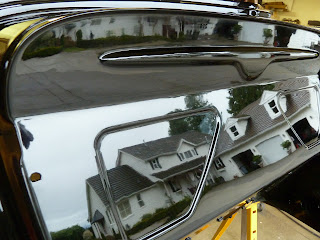Here is my frame after getting it back from the powder coater. Originally, I was going to use some type of paint on the frame but the local powder coater basically offered me a similar price as painting so I decided to go with the powder coat. The plus of powder coating is the almost complete seal over the metal. It is rather like a plastic coating over everything. The negative, is that it has to be ground away if you are going to weld tabs or make repairs.
Speaking of repairs, aircraft inspectors frown on the use of powder coating on a lot of parts. I can remember years ago when I wanted to powder coat some of my Mooney landing gear parts. I was told that should stress cracks develop in the base metal or welds, they can not be seen under powder coating but are visible under normal paint. Since powder coating is similar to a plastic finish the cracks would not become visible until they have propagated to a major problem.
Since I don't plan on having this car off the ground I'm not planning on the needing of a landing gear. |




























